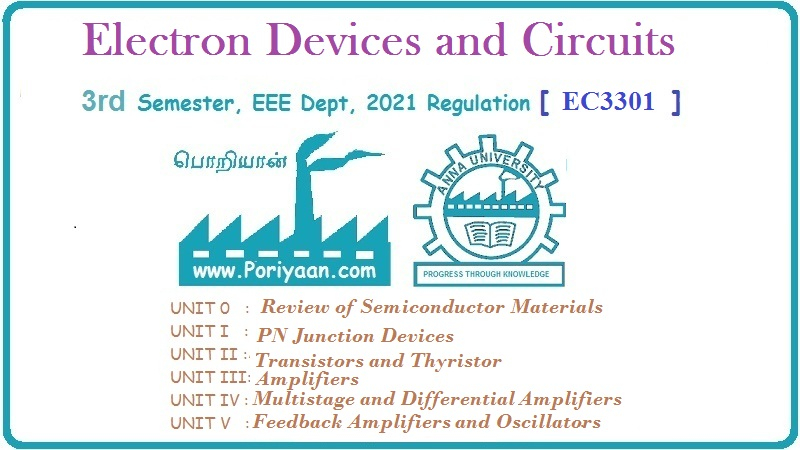Electron Devices and Circuits: Unit II: (a) Bipolar Junction Transistors (BJT)
Bias Compensation Techniques
Bipolar Junction Transistors (BJT)
• As mentioned earlier, compensation techniques use temperature sensitive devices such as diodes, transistors, thermistors, etc. to maintain operating point constant.
Bias Compensation Techniques
•
As mentioned earlier, compensation techniques use temperature sensitive devices
such as diodes, transistors, thermistors, etc. to maintain operating point
constant.
AU
: May-03, 10, 13, Dec.-04, 09, 10, 12
1. Diode Compensation for VBE
•
Fig. 2.9.1 shows the voltage divider bias with bias compensation technique.
•
Here, separate supply VDD is used to keep diode in forward biased condition.
•
The diode used in the circuit is of same material and type as the transistor.
Thus, the voltage across the diode will have the same temperature coefficient
(-2.5 mV/ ° C as the base to emitter voltage VBE-
•
So when VBE changes by 3 VBE with change in temperature, VD changes by 3 VD and
3 VD = 3 VBE.
•
These changes tend to cancel each other.
•
Applying KVL to the base circuit of Fig. 2.9.1 we have

Considering
leakage current we have,

Substituting
the value of IB in equation (2.9.1) we have

Since
VD tracks VBE wiA respect to temperatae, it is dear from
equation (2.9.2) that IC will be insensitive to variations in VBE
2. Diode Compensation for ICO
•
In case of germanium transistors, changes in Ico with temperature are
comparatively larger than silicon transistor.
•
Thus, in germanium transistor changes in Ico with temperature play the more
important role in collector current stability than the changes in the VBE
•
The Fig. 2.9.2 shows diode compensation technique commonly used for stabilizing
germanium transistors. It offers stabilization against variation in ICO.

•
In this circuit diode is kept in reverse biased condition. In reverse biased
condition the current flowing through diode is only the leakage current.
•
The diode and the transistor are of the same type and material, hence the
leakage current IO of the diode will increase with temperature at the same rate
as the collector leakage current ICO.
From
Fig. 2.9.2 we have
I
= VCC – VBE / R1 and I = IB + IO
IB
= I – IO
•
For germanium transistor VBE = 0.2 V, which is very small and
neglecting change in VBE with temperature we can write,
I
≅ VCC / R1
≅ constant
'We
know, IC = β IB +(1 + β)ICO, Substituting
value of IB in above equation we get,

•
As I is constant, Ic remains fairly constant. In other words we can say that
changes by ICO with temperature are compensated by diode and thus collector
current remains fairly constant.
3. Thermistor Compensation Technique
This
method of transistor compensation uses temperature sensitive resistive
elements, thermistors rather than diodes or transistors. It has a Negative
Temperature Coefficient (NTC), its resistance decreases exponentially with
increasing temperature as shown in the Fig. 2.9.3.

•
Fig. 2.9.3 (a) shows thermistor
compensation technique. As shown in Fig. 2.9.3 (a), R2 is replaced by thermistor
RT in self bias circuit.

•
With increase in temperature, RT decreases. Hence voltage drop across it also
decreases.
•
This voltage drop is nothing but the voltage at the base with respect to
ground. Hence, VBE decreases which reduces IB. This behaviour will
tend to offset the increase in collector current with temperature.
IC
= βIB + (1 + β) ICO
•
In this equation, there is increase in ICO and decrease in IB
which keeps IC almost constant.
Review Questions
1. What is bias
compensation using thermistor ?
AU : ECE : May-03,
Marks 2
2. Draw a circuit that
minimizes change in VBE due to temperature variation.
3. Explain the method
of stabilizing the Q point.
AU : ECE : Dec.-09,
12, Hay-13, Harks 16
4. Explain the circuit
which uses a diode to compensate for changes in VBE and in ICO
AU ; ECE : May-10,
Marks 8
5. Discuss the
operation of thermistor compensation.
AU : ECE : May-10,
Harks 4
6. How can collector
current be stabilized with respect to lco variations ?
7. Why is temperature
compensation required ?
AU : ECE : Dec.-12,
Marks 2
8. Explain bias
compensation.
AU : ECE : Dec.-12, May-13,
Marks 8
Electron Devices and Circuits: Unit II: (a) Bipolar Junction Transistors (BJT) : Tag: : Bipolar Junction Transistors (BJT) - Bias Compensation Techniques
Related Topics
Related Subjects
Electron Devices and Circuits
EC3301 3rd Semester EEE Dept | 2021 Regulation | 3rd Semester EEE Dept 2021 Regulation
